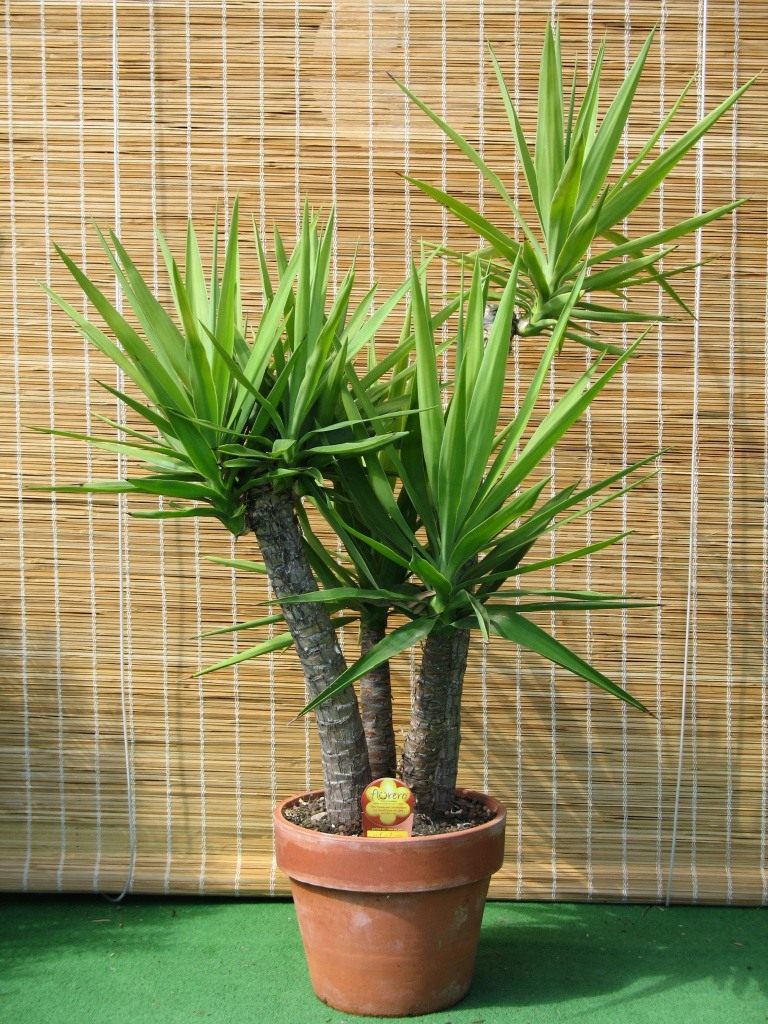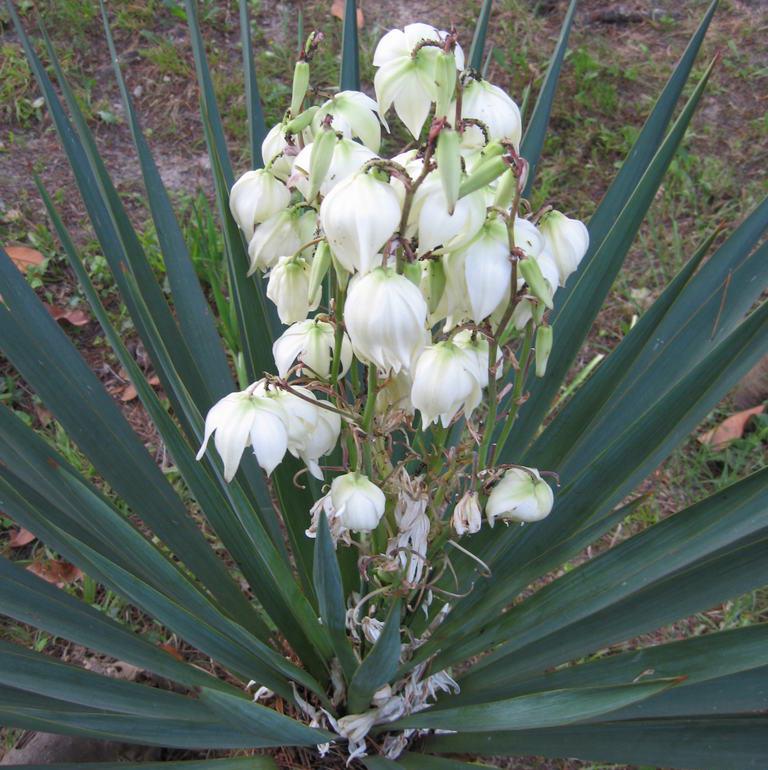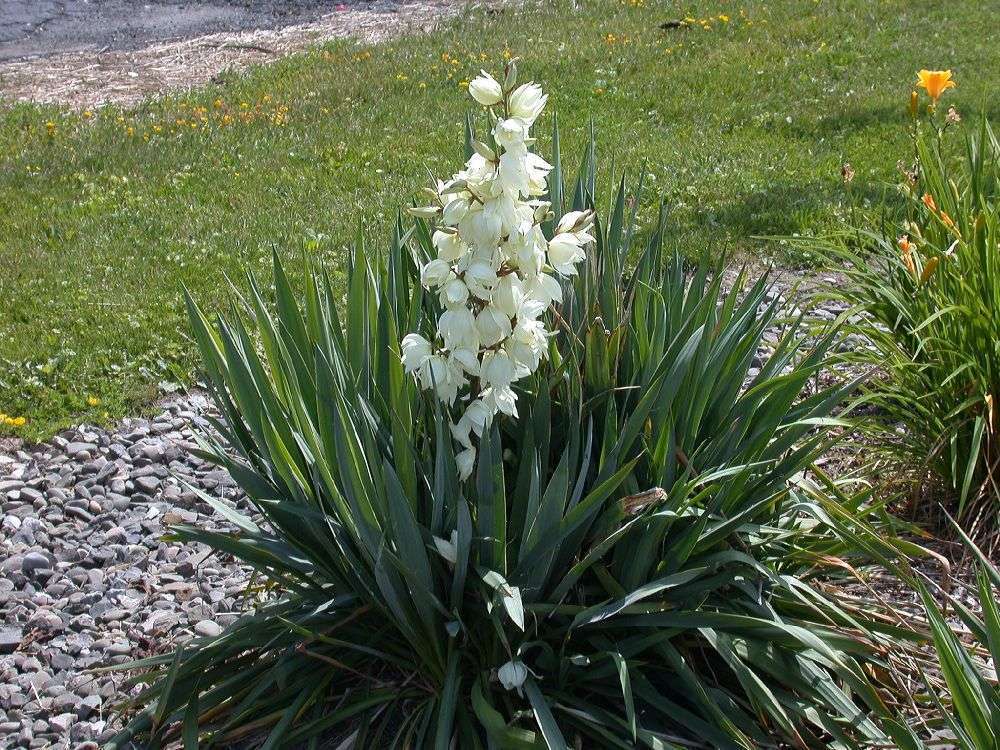The beautiful evergreen yucca plant is prized by flower growers for its graceful trunk and beautiful dark or bluish-green leaves at its top. Depending on the species, the stem can have several points of growth and branch beautifully, and the leaves can be either erect or drooping. The tree is unpretentious and care for it is not difficult. Therefore, yucca is often chosen for decorating a room, office or creating a composition. There are many tree varieties, but only a few specimens are used for growing in indoor and garden conditions, the distinctive features of which can be read in this article.
Content
Yucca plant - general characteristics
A beautiful perennial plant belongs to the agave family, and naturally grows in the subtropical zones of North America. The low stem of the tree does not branch, or may branch slightly. In some stems, it is so short that it is practically invisible, and beautiful leaves rise directly above the ground. Large erect inflorescences are very similar to panicles. They grow from the center of the outlet and can be up to two meters long. The inflorescences consist of drooping white flowers in the form of a bell. Each flower reaches seven centimeters in length. The fruit is a box, inside of which black seeds are formed.
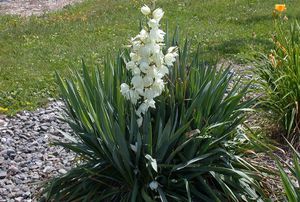 A tree that looks like a false palm tree in spacious rooms can grow up to 4 meters in height. Only adult plants bloom. Even with proper placement and good home care, flowering is rare. Experienced growers, when the plant reaches the required age, stimulate the formation of buds by organizing a dormant period in winter. For this, yucca is kept indoors with a temperature within 12-14C.
A tree that looks like a false palm tree in spacious rooms can grow up to 4 meters in height. Only adult plants bloom. Even with proper placement and good home care, flowering is rare. Experienced growers, when the plant reaches the required age, stimulate the formation of buds by organizing a dormant period in winter. For this, yucca is kept indoors with a temperature within 12-14C.
The slowly growing trunk of a young tree can be given an interesting shape by a certain pruning method, and used in compositions along with home bonsai. A tall adult plant looks impressive in a single planting or in combination with palms, ficuses and beautifully flowering large crops.
Aloe and elephant yucca can be grown in the same container with similar dry-resistant plants. It can be pelargonium, Kalanchoe, sansevier. In the open field, filamentous yucca is grown, which is a tree with dark green leaves.
This flower in the world of gardeners is known as sansevier. Among amateurs, it is also called "pike tail":https://flowers.bigbadmole.com/en/lekarstvennye-rasteniya/kakoy-vred-ili-polza-ot-cvetka-schuchiy-hvost.html
Yucca - species description
The Yucca genus unites more than 30 perennial tree-like plants. Only a few of them are grown at home.
Yucca elephant... In old age, a tree with a height of 4 to 8 meters resembles a huge elephant leg. The plant grows in Central America, where it grows slowly, taking the form of a tree or upright bush. Distinctive features of the Yucca elephant:
- Strongly branched tree trunk.
- Fibrous, tough leaves growing at the ends of the stems.
- Leathery, elongated lanceolate, light green leaf blade reaches a length of 50-100 cm, has a sharp spike at the end and serrated edges.
- Paniculate inflorescences consist of many hemispherical flowers and grow up to one meter in length.
The most popular among the plants of this species is the Variegata variety, which is distinguished by leaves with a white-yellowish border.
Aloe leaf yucca... An unpretentious and widespread plant in nature can be found in Bermuda, in the southern part of North America, in Jamaica, in Central America. Aloe leaf yucca is different:
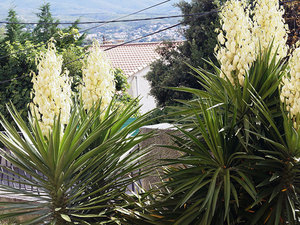 Slow growth.
Slow growth.- Up to 8 meters high.
- A tree-like stem, which branches strongly in adult specimens.
- Rosettes with fibrous leaves located on the tops of the branches.
- Dark green leathery lanceolate leaves with serrated edges and a thorn at the top.
- Paniculate inflorescence up to one and a half meters long.
- Bell-like flowers with creamy white petals of purple hue.
Yucca gray... The two-meter tree grows in the western United States. You can find it out by the following features:
- A short trunk with a meter long leathery, fibrous green-blue leaves and white or gray edges.
- A meter-long paniculate inflorescence that grows from a rosette of adult plants.
- Bellflower-like white-cream flowers, of which a large number of inflorescences consist.
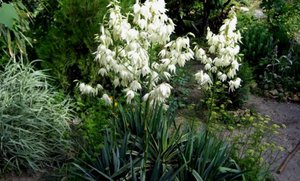 Yucca filamentous... An almost stemless plant native to North America. The root system penetrates deeply into the soil, due to which the tree can withstand short-term frosts from -20C or more. Yucca filamentous planted in open ground grows thanks to root suckers.
Yucca filamentous... An almost stemless plant native to North America. The root system penetrates deeply into the soil, due to which the tree can withstand short-term frosts from -20C or more. Yucca filamentous planted in open ground grows thanks to root suckers.
Leaves of this garden yucca They are distinguished by a bluish-green color, white thin, curly threads on the pubescent edges and a pointed tip. They reach 70 cm in length. Inflorescence in the form of a panicle will grow up to 200 cm and consists of drooping yellowish-white flowers. Seeds ripen in a round box 5 cm in diameter. Their germination can be obtained only after artificial pollination. The plant has a variegated shape with white or yellow variegated leaves.
Cultivation, care and reproduction of yucca at home:https://flowers.bigbadmole.com/en/sadovye-cvety/cvety-yukka-vyraschivanie-v-domashnih-usloviyah-foto.html
Yucca the glorious or spanish dagger... Under natural conditions, the plant grows in the southeastern United States and looks like a two-meter tree. Its stem can be single or weakly branched. The green-blue leaves reach 60 cm in length, have a lanceolate shape, teeth at the edges and a sharp thorn at the top. From the rosettes of adult specimens, paniculate inflorescences, leathery to the touch, grow. They are 2.5 meters long and consist of drooping flowers with creamy petals.
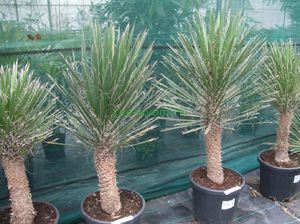 Yucca southern... Strongly branched in the upper part, a powerful tree reaches a height of 8-10 cm. Densely located dark green leathery leaves are only 25-30 cm long. Threads hang along their edges, therefore the second name of the tree is yucca yucca. Hanging, branched, multi-flowered inflorescence grows up to 1-2 meters and consists of cream-colored flowers.
Yucca southern... Strongly branched in the upper part, a powerful tree reaches a height of 8-10 cm. Densely located dark green leathery leaves are only 25-30 cm long. Threads hang along their edges, therefore the second name of the tree is yucca yucca. Hanging, branched, multi-flowered inflorescence grows up to 1-2 meters and consists of cream-colored flowers.
Large-fruited yucca or Schotta... The tree is 3-4 m high in nature grows in southern Arizona. Tough, straight, smooth leaves 2-4 cm wide and 20-50 cm long taper at the base and have a bluish tint. They are covered with fine threads along the edges. The folded inflorescence is a loose panicle.
Yucca Trekula. The slow-growing evergreen tree is native to the southern United States and Mexico. On a slightly branched stem, up to 5 m high, slightly curved leathery bluish-green leaves are collected in dense rosettes. They grow up to one meter in length and have an elongated-lanceolate shape. The tree blooms in summer with creamy white, bell-like hanging flowers, which are collected in paniculate inflorescences one meter long.
Yucca folded... A low plant up to one and a half meters high is distinguished by a short trunk, fibrous, rigid single or branched leaves and an elongated lanceolate leaf plate. Grayish-green leaves with a thorny thorn at the end and jagged edges grow up to 90 cm in length.
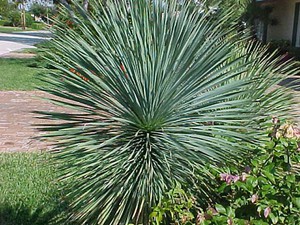 Yucca radiant... Under natural conditions, a tree can grow up to seven meters. Numerous linear leaves up to 60 cm long are densely packed. Weakly grooved leaf plates with a sharp top are distinguished by narrow white edges with a large number of fine filaments. The panicle-shaped inflorescence grows up to two meters.
Yucca radiant... Under natural conditions, a tree can grow up to seven meters. Numerous linear leaves up to 60 cm long are densely packed. Weakly grooved leaf plates with a sharp top are distinguished by narrow white edges with a large number of fine filaments. The panicle-shaped inflorescence grows up to two meters.
Yucca beak... A plant with a branched crown and a thick trunk grows up to three meters. Long and thin numerous leathery leaves are only 1 cm wide. The biconvex flat striped leaf plate has yellow serrated edges and a sharp subulate apex. White flowers are collected in a panicle inflorescence.
Short-leaved yucca... The tree is native to Arizona and southeastern California, where it grows in open, dry areas. In height, it can reach 9 meters, in connection with which it has a second name - giant yucca. On a highly branched trunk with a diameter of 50 cm, hard leaves are densely located. Leaf plates 15-30 cm long are triangularly widened towards the base and spiny at the apex. At the edges, the brown leaf plates are pale green. The short peduncle with a dense panicle consists of pale yellow flowers.
Yucca Whippla... A bushy plant native to California, Arizona, and northwestern Mexico. On the shortened stem are elongated-lanceolate, rigid fibrous leaves. They are collected in rosettes with a diameter of more than one meter and have a grayish-green color. The leaf plate is distinguished by a spike at the end and serrated edges. The bell-like flowers have a delicate aroma and creamy white petals with a purple hue. They gather in a paniculate inflorescence up to two meters long. Monocarpic rosette of leaves blooms only once. After it dies off, many processes begin to form at the base of the bush.
Features of yucca care
The tree grows well in a bright, warm room near the southern windows.
How to make your yucca fluffier by trimming and shaping the crown:https://flowers.bigbadmole.com/en/sadovye-rasteniya/yukka/kak-mozhno-sdelat-yukku-bolee-pushistoy.html
Temperature regime and air humidity
Optimum temperature for growing yucca from +20 to + 25C... In winter, the tree should be kept in rooms with an air temperature of about + 10C. The plant does not like drafts and hypothermia.
Aloe-leaf yucca and elephant yucca are undemanding to air humidity. Plant species sensitive to air humidity should be sprayed regularly.
Watering and feeding
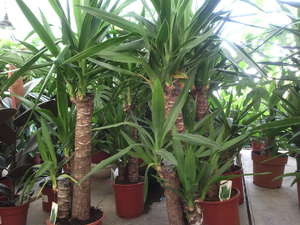 The frequency of watering yucca depends on the air humidity and temperature in the room, the characteristics of the substrate, the size of the plant and the size of the pot. In the warm season, the tree is watered abundantly only after the topsoil has dried not less than 5 cm... When the plants are kept in a cool room in winter, watering is reduced. Otherwise, due to standing water in the soil, the roots will begin to rot and the tree will die. Therefore, it is better to dry the yucca than to pour.
The frequency of watering yucca depends on the air humidity and temperature in the room, the characteristics of the substrate, the size of the plant and the size of the pot. In the warm season, the tree is watered abundantly only after the topsoil has dried not less than 5 cm... When the plants are kept in a cool room in winter, watering is reduced. Otherwise, due to standing water in the soil, the roots will begin to rot and the tree will die. Therefore, it is better to dry the yucca than to pour.
In spring and summer, the plant is fed every three weeks with special organic or mineral fertilizers. But best of all, yuccas respond to foliar feeding. To do this, the leaves are sprayed from the underside with a solution of mineral fertilizer.
A tropical plant is unpretentious, but requires special attention and some care. True lovers of beauty will enjoy taking care of the yucca, which can be an excellent decoration for an apartment or a summer cottage.
